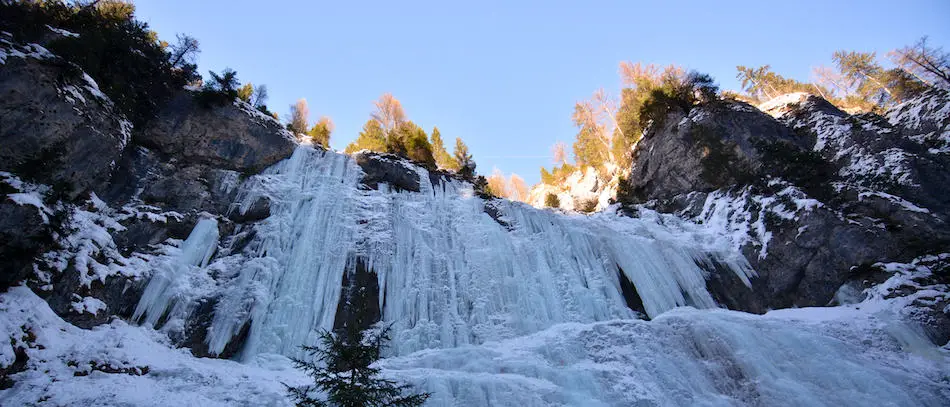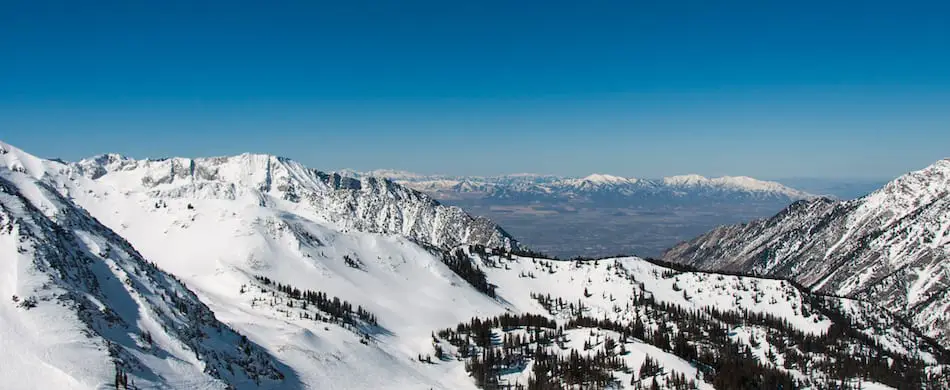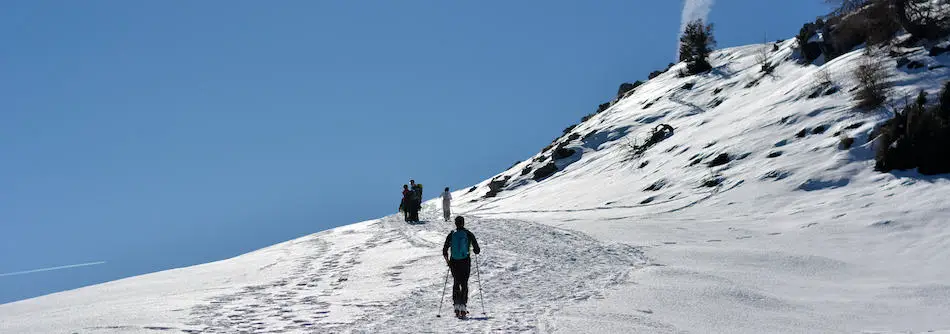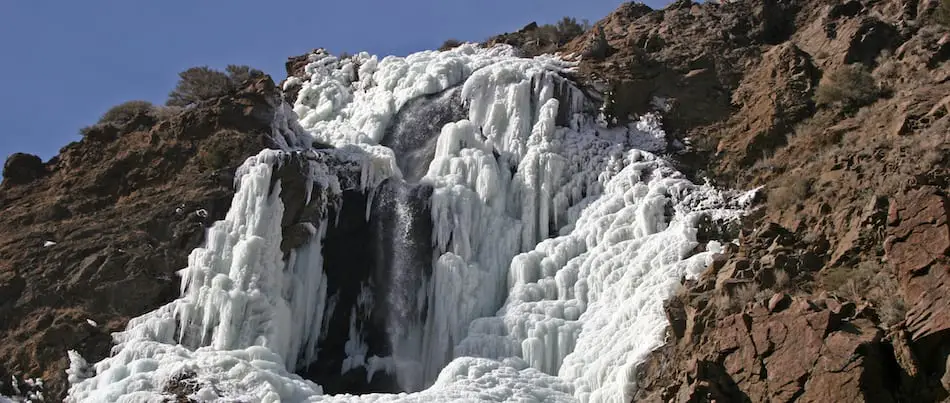
When looking for somewhere to take a winter trip, I started doing some research on ice climbing in Utah and found that there wasn’t much information available. I created the following guide to help you plan for your next trip!
Ice climbing in Utah is mainly concentrated into the state’s many canyons such as Provo, Little Cottonwood, and Maple. The season is short, with December and January being the only two months in which ice reliably forms, and the crags are often crowded. Despite that, there is still world-class climbing to be found.
To get more information about ice climbing in Utah, I called up local guiding company Utah Mountain Adventures and spoke to one of their employees, who gave me much of the information that you’re going to find here (plus told me about a hidden gem, found in the guide below). While not as famous as other locations such as Colorado, Utah still has some excellent ice climbing crags, as well as some famous alpine routes to test your multi-pitch skills on. If you have some time over the holidays and you want to go ice climbing, Utah is a great place to go!
If you want to take this guide with you, download it as a PDF below:
Utah Ice: An Overview
Known mostly for their jaw-dropping geological formations and world-class hiking, Utah doesn’t get that much attention as a winter travel destination. For ice climbers, however, the state yields a good variety of climbs for all levels of experience.
As I said above, much of the ice climbing in Utah takes place in the canyons of the Wasatch and San Pitch mountains. Because of this, climbers can expect short approaches and long days, as they don’t need to worry about the sun warming their routes and making them unclimbable. Crags are often easy to get to and offer a wide variety of routes to climb on.
Located in the western part of the central USA, Utah is an easy location to travel to. Salt Lake City has a fully serviced international airport, and is fairly centrally located as a jumping-off point for any would-be adventurers.
Season
The one downside of Utah ice climbing is how short the season is. Usually, good quality ice is only found in December and January, with February sometimes holding out for a little bit of late season action. Any earlier and the ice will be unsafe, and by March spring has come and climbers must pack up their gear for next season.
This short season can make planning a trip to Utah slightly risky, as there’s always the chance that the weather is going to change and impact your ability to ice climb. In fact, many of the region’s best climbs don’t always come in every season (especially multi-pitch routes). This means that going to Utah can take some flexibility and last-minute planning.
You should also watch out for mid-winter thaws that can raise temperatures and make the routes unsafe, even in the middle of the climbing season.
Best Locations for Ice Climbing in Utah
If you do manage to find a good weather window, you’ll find that Utah has lots to offer you. The ice is good, the temperatures are mild, and the scenery is guaranteed to be stunning.
According to locals, the best ice climbing in Utah can be found in:
- Provo Canyon
- Little Cottonwood Canyon
- Maple Canyon
- Santaquin Canyon
- Joe’s Valley
Provo Canyon

The most famous ice climbing location in Utah, Provo canyon is the state’s ice climbing mecca. With tens of ice climbs packed into one location, Provo has a route for everyone. If you’re a beginner, there are plenty of WI-2 routes to cut your teeth on; more experienced climbers should check out Stairway to Heaven for some of the state’s most iconic routes.
What to Expect
Provo canyon is guaranteed to have two things: varying climbs and lots of crowds.
Because of how many routes are packed into the canyon, you can be sure that everyone in your party is going to have something to climb. The routes on the south side tend to be a little more solid, because they get less exposure to the ice.
However, the sheer number of available routes also means that Provo is liable to be crowded, especially on weekends. With dozens of cars at the trailhead and up to a hundred climbers in a single day, you need to watch out that you’re not getting in anyone’s way. Icefall can also be a serious danger with so many people climbing simultaneously.
Access
One of Provo’s main features is its ease of accessibility. To get there, Take the I-15 (North or South, depending on where you’re coming from) and exit East on the 8th North Exit in Orem. This will turn into Highway 189, which takes you straight into the canyons.
Most of the ice climbing is located by parking at the Nunn’s Park trailhead. From there, it’s a 15-20-minute walk to the climbs.
Accommodations
Despite its name, Orem is actually the closest city to Provo canyon (not Provo, the city, which would be my first guess). Especially during the offseason, you can find pretty cheap accommodations (less than $100 per night). From Orem, you’re no more than a 20-minute drive from the trailhead.
Gear and Guides
Unfortunately, I couldn’t find much in the way of gear rentals for Provo Canyon. The closest place that rents ice climbing gear is the University of Utah, located in upper Salt Lake City (about a 1-hour drive away). If you’re crunched for time, it might be a better idea to bring your own gear down.
For hiring a guide, though, you’re in luck! Utah Mountain Adventures does ice climbing trips in Provo Canyon, and they’ll happily supply you with all of the gear that you need for your day!
Little Cottonwood Canyon

Located near the heart of Salt Lake City, Little Cottonwood Canyon has a good variety of ice climbs, including the Great White Icicle, one of the state’s most iconic routes.
What to Expect
Known mostly for rock climbing, Little Cottonwood still has enough ice routes to keep you occupied for a couple of days. Beta is harder to come by, but guidebooks can be purchased that will give you all the information you need.
With fewer routes and more multi-pitches, Little Cottonwood is less beginner-friendly than Provo is. Instead, you should head here if you’re interested in ticking off some of the most fun routes in the state — namely, Great White Icicle and Scruffy Band.
Access on the roads can also be significantly worse in the winter. Snow tires and four wheels is a good idea if there’s been fresh snow.
Access
Take either highway 209 or 210, depending on your direction. These two roads converge at the Little Cottonwood Parking Lot; all mileage within the canyon is measured from this spot and identified by a large flashing sign.
All trailheads are located along the main road.
Accommodations
Salt Lake City is the place to be if you plan to climb in Little Cottonwood. As Utah’s main town, there’s an abundance of accommodation for all price points. Try to stay in the south-west region for easier access.
Gear and Guides
If you’re staying in Salt Lake City, you should be able to make the aforementioned drive over to the University of Utah to pick up some rental gear. For people who want a little more help, Utah Mountain Adventures also has guided tours in this area!
Maple Canyon

If you’re looking for a little more adventure, head to Maple Canyon. Located dead smack in the middle of the state, this location features longer approaches, harder routes, and fewer crowds for any seasoned ice climbers out there.
Information on Maple Canyon is hard to come by online. Consider checking out Maple Canyon Ice Climbing by Jason Stevens for more information on vehicular access and routes.
What to Expect
Because of its dry climate, you can’t have ice in Maple Canyon unless you also have snow. This means that the roads and trails leading to the climbs are often covered in a fresh layer of powder, making life more difficult for everyone.
Once you get to the climbs, though, they’re well worth the effort. There are tens of routes in the WI-3 – WI-5 range, many of them multipitch or alpine rotes. While it’s not very beginner friendly, it can be a good place for a more hardened group to test their mettle.
Access
Remember when I said that the roads were often covered in snow? You should be prepared to hike or skin your way to the base of a climb in Maple Canyon, so pack your skis.
To get to there, head south from Salt Lake City and then turn onto Hwy 132. Check out the aforementioned guide for more detailed route approaches.
Accommodations
Nephi is the nearest town, although there isn’t much to do when you’re not climbing. If you don’t mind a longer drive, you can stay in Provo or Salt Lake City and simply hit the road for an hour and a half to get to your location.
Gear and Guides
There’s little to be foud in the way of guided ice climbing in Maple Canyon. If you really want someone to show you around, consider hiring a guide for the day and splitting the cost between your group.
Hidden Gem: Joe’s valley
Known mostly as a rock-climbing destination, Joe’s Valley offers a few high-quality ice climbs without hordes of people that you’ll find at other locations. If you’re looking for a hidden gem in the state to make your trip feel more authentic, this might be it.
What to Expect
Unlike Provo and Little Cottonwood, the climbs here are much more scattered, and the approaches can be more confusing. Once you find a climb, however, you should expect to have an enjoyable time on solid ice and without the crowds of some of the more popular location.
The season in Joe’s Valley tends to be longer than in the rest of Utah; there’s climbing to be found from mid-November to mid-March. Some of the most iconic climbs in the area include Highway to Heaven WI-4, the Amphitheater WI-6 (featured in the video above), and CCC Falls, which is 400 feet of solid WI-4 climbing.
Access
To get to Joe’s Valley, you want to find your way onto State Road 29. All trailhead locations can be found by using the mile markers on this road.
Huntington, Utah is the easiest town to access in the nearby area and can act as a good staging location.
Accommodations
Once again, there’s little to be had in the area surrounding Joe’s Valley. Price, Utah is a decently sized town with reasonable access; for those who want a little more livelihood, I would just stay in Provo and tolerate the 1.5-hour approach.
Gear and Guides
Same as above. Gear rentals and guiding in the area are scare, so maybe keep this location off of your to-do list if you’re not experienced enough to do on your own.
What the Locals Say

As I said, I consulted with a local Utah guide before writing this article. Here are some of the points he had to say about ice climbing in Utah, arranged in no particular order.
Check out Willard Falls!
A rambling, 200-foot WI0-2 ice pillar, Willard Falls (sometimes called Willard Canyon Waterfall) is a great multipitch route to warmup on and get a little bit of exposure to what Utah ice is like.
To get to this climb, drive 50 minutes north of Salt Lake City to get to the Willard City Cemetery. Travel east from here until the road forks; take the right fork and keep going until the road ends. Drop down into the creek and head east until you find the base of the falls (check out a more accurate route description here).
Maple Canyon is a Local Favourite
Home to more adventure and fewer crowds, the guides at Utah Mountain Adventures admitted that they would list this as one of their favourite destinations to climb at (I did ask them to not go spilling any local secrets, though).
That doesn’t mean that the other locations don’t have merit, though! In fact, the guides also claimed that Great White Icicle (Little Cottonwood) and Stairway to Heaven (Provo) were two of their favorite routes.
Good Access
One of the defining features of Utah ice is that many of the climbs have very good access, particularly Provo and Little Cottonwood. The trailheads are close to major cities, and the climbs are close to the trailheads; if you really want, you can be on ice less than hour after leaving your house.
This makes Utah a great place to go cragging, and an ideal location for beginners. The short approaches mean that you are able to spend more time actually on the ice, allowing you to hone your skills and get the laps needed to improve.
Fickle Season
As I mentioned a couple of times in the guide, the season in Utah is probably the main factor that has prevented this state from becoming a world-famous ice climbing destination like nearby Colorado. With only two months of reliable ice, climbers need to plan their trip well to avoid having their season go to waste.
In addition to this, the area is prone to chinooks and mid-season thaws that can ruin the viability of ice climbs for up to two weeks at a time. There’s really no way to plan for this, so you just need to be prepared for the fact that your climb might not be there when you go. Always have a backup ready!
Finally, the shortened season means that many climbs don’t form on any given year. This is especially common for longer routes like those found in Maple Canyon, so you might want to avoid getting too committed to any one route.
Busy crags
The downside of the easy approaches and short season mentioned above is that many crags will be crowded on any given day, as climbers try to cram as much as they can into the 2 months that they have. This is both inconvenient and dangerous; you need to constantly be on the lookout for icefall caused by the climbers above you.
For a more in-depth information and expert advice, given Utah Mountain Adventures a call at 801-550-3986.
